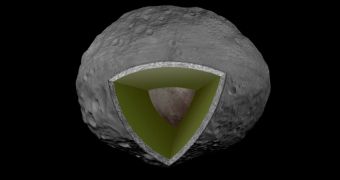According to the conclusions of an investigation conducted by scientists at the NASA Lunar Science Institute (NLSI), it would appear that Vesta, the largest asteroid ever discovered in the solar system, was impacted by space rocks as recent as 1 billion years ago.
Until now, it was believed that the surface of the object has been left largely untouched for a very long time. The asteroid is believed to have formed around the same time as all the planets, around 4.5 billion years ago. In fact, this body is cataloged as a protoplanet.
What this implies is that it may have developed into a rocky world like Mercury, Venus, Earth or Mars, if other factors wouldn't have prevented it from doing so. Recent investigations conducted using the NASA Dawn orbiter have revealed that Vesta has an iron core, just like our planet does.
In the new NLSI study, it was discovered that the giant impact crater Rheasilvia on the surface of Vesta is about 1 billion years old. This implies that the asteroid was impacted by other space rocks more recently than originally calculated.
Data used for this study were obtained from Dawn. The spacecraft entered the first of four orbits around Vesta in July 2011, and is scheduled to continue observing the asteroid until mid-August.
Southwest Research Institute (SwRI) investigator and NLSI member, Dr. Simone Marchi, presents the finding in the May 11 issue of the top journal Science, in a paper entitled “The Violent Collisional History of Asteroid (4) Vesta,” Astrobiology Magazine reports.
According to the expert, the impact that created the large crater must have scattered a lot of debris from the asteroid's surface. Some of this debris may have struck Earth as meteorites. Vesta is known to be the source of about 10 percent of all meteorite fragments found on our planet.
“An age of about 1 billion years for Rheasilvia is unexpectedly young. This result has important implications for our understanding of the evolution of the Vesta, its asteroid family and the inner main asteroid belt in general,” Marchi explains.
“We have just started exploring Vesta’s secrets, and I’m sure other intriguing results will come along shortly,” she goes on to say. Unfortunately, the Dawn spacecraft needs to depart the asteroid's orbit, if mission controllers want to keep it on target for an early 2015 arrival at the dwarf planet Ceres.
Both Vesta and Ceres are located in the Inner Asteroid Belt, between the orbits of Mars and Jupiter.

 14 DAY TRIAL //
14 DAY TRIAL //